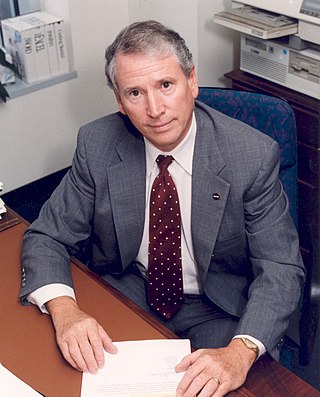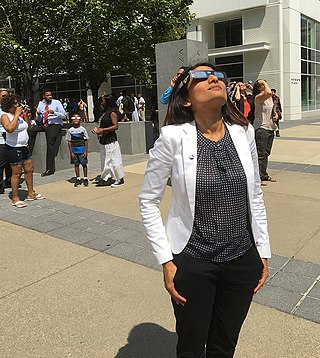Related Research Articles

The Rogers Commission Report was written by a Presidential Commission charged with investigating the Space Shuttle Challenger disaster during its 10th mission, STS-51-L. The report, released and submitted to President Ronald Reagan on June 9, 1986, both determined the cause of the disaster that took place 73 seconds after liftoff, and urged NASA to improve and install new safety features on the shuttles and in its organizational handling of future missions.

Charles Frank Bolden Jr. is a former Administrator of NASA, a retired United States Marine Corps Major General, and a former astronaut who flew on four Space Shuttle missions.

Paul William Richards is an American engineer and a former NASA astronaut. He flew aboard one Space Shuttle mission in 2001.

Jerrol Wayne Littles was the eighth director of the NASA Marshall Space Flight Center located in Huntsville, Alabama. He served as director from February 3, 1996, to January 3, 1998.

George William Samuel Abbey was an American NASA administrator and United States Air Force pilot. Graduating from the Air Force Institute of Technology as an electrical engineer, he then served in the United States Air Force and the Apollo program. He subsequently became director of flight crews for the Space Shuttle, then director of the Johnson Space Center. Honors include the NASA Exceptional Service Medal, the NASA Outstanding Leadership Medal, three NASA Distinguished Service Medals and the 1970 Presidential Medal of Freedom.

Daniel R. Mulville is an American engineer who served briefly as Acting Administrator of NASA in 2001.
Miriam Rodón Naveira is an environmental scientist from San Juan, Puerto Rico, working at the federal government of the United States for which she was awarded a Silver Medal for Superior Service and a Suzanne Olive EEO and Diversity Award both by the EPA. She was also the first Hispanic woman to serve as branch chief of the EPA's National Exposure Research Laboratory (NERL) and later the first Hispanic woman to become deputy director of NERL's Environmental Sciences Division. Working at NASA since 2000, she now oversees research to enhance collaboration within DFRC, as well as with external entities, in support of the integrated use of remote sensing instruments in aerial platforms.

William H. Gerstenmaier is an aerospace engineer and policymaker who is Vice President, Build and Flight Reliability at SpaceX. He previously served as NASA's Associate Administrator for Human Exploration and Operations between 2005 and July 10, 2019. While in that role, he was described as "arguably the most influential person when it comes to US spaceflight." Prior to being Associate Administrator, Gerstenmaier served as the International Space Station Office Program Manager, at Johnson Space Center, a position he began in June 2002. He spent a total of four decades with NASA.
The Science Mission Directorate (SMD) of the National Aeronautics and Space Administration (NASA) engages the United States' science community, sponsors scientific research, and develops and deploys satellites and probes in collaboration with NASA's partners around the world to answer fundamental questions requiring the view from and into space.

Goddard Space Flight Center is NASA's first, and oldest, space center. It is named after Robert H. Goddard, the father of modern rocketry. Throughout its history, the center has managed, developed, and operated many notable missions, including the Cosmic Background Explorer, the Hubble Space Telescope, the Tracking and Data Relay Satellite System (TDRSS), the Lunar Reconnaissance Orbiter, and the Solar Dynamics Observatory.

Wanda M. Austin is a former president and CEO of The Aerospace Corporation. She was both the first woman, and the first African-American, to hold this position. Austin also served as interim president for the University of Southern California, following the resignation of C. L. Max Nikias. She was both the first woman, and the first African-American, to hold this position.

Tara Melaine Ruttley is Associate Chief Scientist for Microgravity Research at NASA Headquarters in Washington, DC. Prior to this, she was Associate Program Scientist for the International Space Station (ISS) at NASA's Johnson Space Center in Houston, Texas. Until 2007, she was lead hardware engineer for the ISS Health Maintenance System, leading a team of engineers whose job was to provide reliable medical equipment that kept astronauts healthy in orbit. She subsequently served as the lead hardware engineer for the ISS Human Research Facility. She served as an aquanaut on the NASA Extreme Environment Mission Operations 6 crew in July 2004.

Dr. Colleen Hartman is currently the Board Director for the Space Studies Board as well as the Aeronautics and Space Engineering Board of the National Academies of Sciences, Engineering, and Medicine in Washington, D.C. She was the deputy center director for Science, Operations and Performance of NASA’s Goddard Space Flight Center and most recently, was the Director of the Science and Exploration Directorate. Previously she was acting Associate Administrator of the Science Mission Directorate (SMD), Deputy AA of SMD and presidential management intern, served as a senior policy analyst at the White House Office of Science and Technology Policy, and served as deputy division director for technology at NASA Headquarters.

Since its establishment in 1958, NASA has conducted research on a range of topics. Because of its unique structure, work happens at various field centers and different research areas are concentrated in those centers. Depending on the technology, hardware and expertise needed, research may be conducted across a range of centers.

Dr. Mamta Patel Nagaraja is an American engineer and scientist, and currently the Associate Chief Scientist for Exploration and Applied Research. In this role, she advises NASA's chief scientist on missions where humans perform science in spaceflight. She has degrees in aerospace engineering, mechanical engineering, and biomedical engineering. Her dissertation research was in molecular biology where she studied genetic changes in bone cells exposed to simulated microgravity. She previously received two interviews to become a NASA astronaut, served on the NASA Administrator's team, led a science communications portfolio, and served on a White House Council.

Adena Williams Loston is the 14th president of St. Philip’s College. She was installed as the new president in ceremonies on March 1, 2007.

Rita M. Sambruna Commander OMRI (Hon) is an Italian-American astrophysicist and is the Deputy Director of the Astrophysics Science Division at National Aeronautics and Space Administration's (NASA) Goddard Space Flight Center. From September 2022 to May 2023, she was the Acting Deputy Director of the Science Exploration Directorate at Goddard. Rita held the Clare Boothe Luce Professorship in Physics and Astronomy at George Mason University in 2000-2005.

Stephen G. Jurczyk was an American engineer who served as the Acting Administrator of NASA. He previously worked at Langley Research Center in Hampton, Virginia.
Ann Fite Whitaker is a retired American physicist who worked for many years at NASA on the effects of space environments on materials. Although she trained to become an astronaut, she never went to space.
References
- 1 2 3 4 5 6 7 8 9 10
 This article incorporates public domain material from Dr. Wanda Peters. National Aeronautics and Space Administration . Retrieved November 21, 2023.
This article incorporates public domain material from Dr. Wanda Peters. National Aeronautics and Space Administration . Retrieved November 21, 2023. - 1 2 3 4 5 6 Obusek, Gabrielle. "More Women Follow their Dreams to STEM". No. Winter 2021. CatholicU. Retrieved November 21, 2023.
- ↑ "ALUMNI ACHIEVEMENT AWARDEES". The Catholic University of America. Retrieved November 21, 2023.
- ↑ "Wanda C. Peters, PhD". Institute of Electrical and Electronics Engineers. October 3, 2022. Retrieved November 21, 2023.